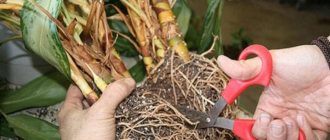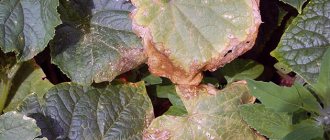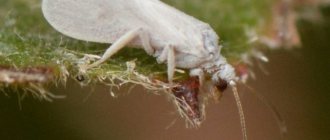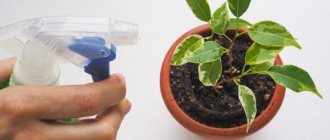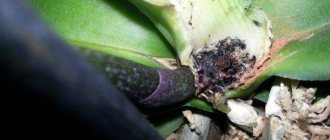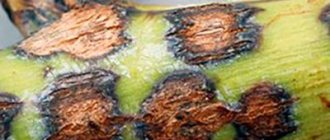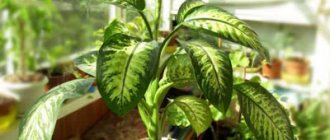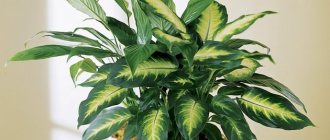Dieffenbachia diseases
date of article: 01/11/2012
Dieffenbachia leaf spot.
Spotting on Dieffenbachia leaves is caused by the fungus Phaeosphaeria eustoma (Fuckel) L. Holm.
Signs of the disease. The lower, older leaves are most damaged, especially along the edges. Small round spots appear on the leaf blade of plants, growing as the disease progresses. The spots have a brown center and an orange border.
The pathogen persists on the remains of infected plants and is transmitted by water. Plants exposed to high air humidity and elevated temperatures are more severely damaged.
Control measures. Maintaining optimal air humidity and temperature conditions. When signs of disease appear, treatment with systemic fungicides is carried out.
Fusarium Dieffenbachia.
Fusarium disease in Dieffenbachia is caused by the fungus Fusarium solani (Mart.) Sacc.
Signs of the disease. Elongated, depressed spots of dark shades appear on the root collar and roots of the plant. As a result of damage to the stems, plants turn yellow and wilt. In case of high humidity of the substrate and air, the damaged areas are covered with light pink mycelium of the fungus.
The pathogen can survive in the soil for a long time, and it is very resistant to external influences.
The spread of the disease occurs with contaminated soil, as well as when the roots of a diseased and healthy plant come into contact. Plants that have a lack of potassium in the substrate, as well as those that are overdried, are especially susceptible to the disease.
Control measures. Use of quality substrates. When cuttings, only healthy material is used; it is recommended to immerse the cuttings in a fungicide solution for about 15 minutes for disinfection. For preventive purposes, spraying with biological fungicides is carried out, for example, Trichodermin (Glyocladin). If a disease is detected, the plants are treated with systemic fungicides, for example, such as Rovral, Fundazol.
Dieffenbachia anthracnose.
Anthracnose in Dieffenbachia is caused by the fungus Colletotrichum gloeosporioides (Penz.) Penz. and Sacc .
Signs of the disease. Quite large spots appear on the leaves along the edge of the leaf blade. As the disease progresses, the leaf dries out as the spots spread over the entire surface of the leaf. The pathogen persists in infected plant debris.
Plants kept at high air temperatures and high air humidity are especially susceptible to the disease. Overmoistening of the substrate also contributes to the disease.
Control measures. Contents taking into account the characteristics of growing the plant. When signs of disease appear, treatment is carried out with systemic fungicides, for example, such as Vitaros, Fundazol.
Dieffenbachia root rot.
The causative agents of Dieffenbachia root rot are species of fungi from the genera Pythium and Phytophthora .
Signs of the disease. Withering of the plant, followed by its death. Depressed dark areas appear on the root collar and on the roots of plants; as the disease progresses, they cover the entire tissue, and in this place the plant rots, breaks and lies down. Light gray fungal mycelium develops on the spots.
The pathogen persists in the soil, from where plants become infected.
Excess fertilizer in the substrate, lack of lighting, poor ventilation, excessive watering, too moisture-intensive substrates, high temperatures - all these factors lead to the fact that the plant is more susceptible to damage by the pathogen. The difference in temperature of the substrate and air, exceeding 6-8 ° C, also contributes to the development of rot.
Control measures. The use of high-quality, well-aerated substrates with a neutral reaction, correct agricultural technology, fertilizing with fertilizers with a high potassium content. If signs of disease appear, watering is stopped, the substrate is partially changed to a new, dry one, and treatment is carried out with systemic fungicides, for example, Profit Gold, Ridomil Gold, Previkur.
Dieffenbachia bacteriosis.
Bacteriosis in Dieffenbachia is caused by the bacterial species Erwinia carotovora subsp. carotovora (Jones) Bergey et al and Erwinia chrisantemi Barras et al.
Signs of the disease. Watery spots with a sharply defined edge appear on the stems of the plant, both above and below the soil. Afterwards the spots become brown or gray in color. Watery spots also appear on the leaves, becoming light brown in color and having a yellow border.
The pathogen persists in the remains of infected plants until they are completely decomposed, and is transmitted through cuttings or due to mechanical damage. The pathogen develops especially actively in conditions of high humidity and temperature, with an excess of nutrients in the soil. Oppressed plants are more damaged by this disease.
Control measures. Compliance with the regime of agricultural technology, destruction of diseased plants, use of clean tools for cutting plants.
Bronzing of Dieffenbachia.
The causative agent of viral bronzing in Dieffenbachia is Tomato spotted wilt virus .
Signs of the disease. The plant has concentric circles, ring-shaped spots, and yellowish arcs appearing on its leaves. As the disease progresses, the leaves wither, burn symptoms appear, and the stems may experience unilateral leaf necrosis on the infected side of the stem. aThe leaves remain hanging on the plant. The plant slows down its growth processes.
The pathogen is carried by pests. In particular, various species of the thrips genus.
Control measures. Timely treatment with insecticidal preparations.
Dieffenbachia mosaic.
Viral mosaic in Dieffenbachia is caused by Dasheen mosaic virus .
Signs of the disease. The growth processes of the plant slow down, and mosaic spots appear on the leaves.
The pathogen persists in infected plants and is transmitted by insect pests, mainly aphids, also with cuttings from diseased plants.
Control measures. Use of healthy plants for propagation, timely spraying of plants with insecticidal preparations.
In our article about Dieffenbachia you can familiarize yourself with its cultivation and various types.
If you have problems with your Dieffenbachia, but you cannot determine what’s wrong with it on your own, you can always contact us for help on our flower forum.
Article prepared by: Marina and Alexander Mityaev
Diagnosis of pityriasis
If you find suspicious spots on the skin, you should promptly contact a dermatologist. During a visual examination, the doctor assesses the nature of the rashes, their shape, size, location on the body and is able to make the correct diagnosis. After dermatoscopy, the following studies are additionally carried out: biochemical tests of blood and urine, RMP (microprecipitation reactions with antigens), skin scrapings from injured areas.
A more complex diagnosis is carried out if the skin disease lasts more than six weeks. In these cases, discharge from the affected lesions is sent for bacterial culture. A biopsy and subsequent histological studies will help make the correct diagnosis. In order to distinguish Zhiber's disease from other types of lichen, toxicerma, psoriasis, complicated syphilis and other pathologies, fluorescent diagnostics are carried out, scrapings are checked for the presence of pathogenic fungi, RPR tests are done for syphilis, etc.
Dieffenbachia ailments: how to help cope with them.
Dieffenbachia (lat.) is an evergreen tropical plant, its homeland is the humid forests of Central and South America.
Dieffenbachia can reach two meters in height, the leaves are large, wide, and variegated.
With good, competent care, Dieffenbachia pleases with its exotic beauty, the flower develops well, and new leaves constantly appear. But what to do if your “green household member” gets sick?
Most often, gardeners growing Dieffenbachia are faced with the fact that its leaves begin to turn yellow, dry out and curl, and there are other problems - the flower grows poorly and becomes lethargic.
What is the cause of the malaise: improper care at home or a pest attack? Let's look at all the "sores" of Dieffenbachia in more detail and try to determine the cause of their occurrence and methods of treatment.
Varieties for home cultivation
The following Dieffenbachia hybrids are best suited for keeping in a room:
- Spotted.
It grows no more than a meter in length, covered with round leaves pointed at the tips. The plates are covered with white and yellow spots.
- Camilla.
A compact bush with yellowish leaves, the green border gives them special beauty.
- Lovely.
Beautiful symmetrical leaves with a dark green color with white longitudinal veins.
- Bush.
It is distinguished by tough dark foliage and a white stripe in the middle of the plate.
The maintenance rules for each hybrid do not differ significantly.
Dieffenbachia diseases and their treatment
How to help a tropical beauty?
- Dieffenbachia leaves turn yellow, reasons, what to do? Solution to the problem:
- low air humidity. Dieffenbachia, not receiving enough moisture from the air, also begins to turn yellow, so in winter it should be kept away from central heating radiators or buy an air humidifier;
- direct sunlight, there should be enough light;
It is necessary to check whether the roots of the flower have actually begun to rot. To do this, you need to remove the plant from the pot, inspect the root system, remove rot and affected areas of the root, transplant the flower into another smaller container, observing the planting rules (drainage 1/3 of the pot, 2/3 soil mixed with sand and peat)
- low air temperature. Dieffenbachia is a tropical resident, it loves warmth, so the temperature in the room should not fall below 22 degrees;
- drafts, which the flower really does not like, so it is better to keep Dieffenbachia away from the balcony door and windows;
- Dieffenbachia dries and its leaves fall off, the tips of the leaves dry and wither, causes and solution to the problem:
- fungal infections (atracnose, leaf spot), fungal spores (leaf spot) can be obtained by the plant with irrigation water; dry brown spots appear along the edges of the leaves, gradually spreading over the entire surface of the leaf, it becomes lethargic and lifeless.
- drafts, low air temperatures can also lead to leaves drying out and falling off; to eliminate the Dieffenbachia problem, you need to ensure a comfortable microclimate in the room;
- the plant ages, the lower leaves dry out and fall off, this is a natural process. It is necessary to rejuvenate it by cuttings. To do this, the bare trunk of Dieffenbachia needs to be cut into cuttings, leaving only a small part of the stem in the pot, which will soon give rise to a new shoot and Dieffenbachia will continue to grow;
- root rot, which appears when the soil is overly fertilized and moistened. Rot first affects the root system, then gradually affects the trunk, the flower withers and dies. It is necessary to replant Dieffenbachia, having previously treated the roots with a fungicide and limit watering;
- overmoistening in combination with low air temperature, in this case it is necessary to provide the plant with a comfortable temperature and limit watering.
Athracnose is provoked by excessively high temperature in the room, dry air, in some cases, waterlogged soil (excessive watering); to get rid of this problem, it is enough to normalize the temperature and watering regime; the affected leaves can be treated with a regular fungicide to prevent infection of other leaves;
To combat fusarium, the flower must be transplanted into another pot, after removing rot from the roots and treating the affected areas with a fungicide;
- When watering with cold water, it is advisable to leave the water for irrigation for at least 24 hours;
- drafts and low room temperature;
- pest attack.
- viral lesions (bronzing and viral mosaic), usually carried by insects, yellow round spots (bronzing) or a mosaic of spots (viral mosaic) appear on the leaves of the plant, Dieffenbachia withers and stops developing. It is almost impossible to cope with such a problem; the flower must be destroyed;
- there is not enough light. You need to move the flower to a brighter room, but remember that the flower does not tolerate direct sunlight;
- insufficient watering. The soil in the pot should always be slightly damp;
- lack of fertilizers in the soil. The lack of fertilizers, as well as their excess, negatively affects the growth and development of Dieffenbachia; the fertilizer must be used strictly according to the instructions indicated on the packaging;
- excessive watering. The flower protects itself from excess moisture in the soil; a similar phenomenon can be observed before rain; the plant opens channels for moisture to escape, preparing for an excess of water.
In the photo below you will see the symptoms of the disease in Dieffenbachia:
Why is arthrosis dangerous?
Arthrosis is a disease that develops slowly and rarely causes severe disability. Periodically developing inflammatory processes pose a danger.
Therefore, in recent years, they have begun to distinguish a disease such as osteoarthritis or osteoarthritis (OA), depending on which process predominates in the joint - degenerative-dystrophic or inflammatory. It is OA that causes severe impairment of limb function.
Stages of arthrosis
Clinical and radiological stages of arthrosis according to the Kellgren-Lawrence classification:
- Zero. The patient feels discomfort, sometimes pain when walking. There are no changes on the x-ray.
- Initial (doubtful). The patient is bothered by moderate dull pain when walking for a long time, sometimes a slight crunch when bending a limb. X-ray: slight narrowing of the joint space, small areas of marginal bone defects.
- Easy. The pain intensifies, appears in the morning along with short-term stiffness, and intensifies with movement. X-rays of grade 2 show: a clear narrowing of the joint space and isolated bone growths (osteophytes) along the edges of the articular surfaces.
- Moderate (degenerative). Night pain syndrome appears. Bones and muscles hurt. Sometimes the joint swells slightly and the pain intensifies (a sign of inflammation). On X-ray: even greater narrowing of the joint space and proliferation of osteophytes; bone density increases (osteosclerosis).
- Heavy (deforming). The pain is constant, aching, intensifies with movement, a rough crunching sound when bending the limb, muscle atrophy and deformation. On the x-ray: the joint space is sharply narrowed, the edges of the articular surface have grown significantly, which has led to a change in the structure and deformation of the joint. Read more about deforming arthrosis in this article.
Stages of arthrosis
Possible complications
Arthrosis is a disease complicated by:
- chronic pain syndrome that increases from physical activity;
- joint deformity;
- dysfunction of the limb - stiffness, alternating with complete or partial immobility;
- loss of ability to work and disability.
Exacerbations of arthrosis
Degenerative diseases are characterized by a slow progressive course. Increased pain occurs in damp, cold and windy weather, as well as when inflammation occurs. Inflammatory processes occur with slight swelling and moderate pain. As a rule, the inflammatory process is aseptic in nature, but in the presence of foci of infection and chronic diseases, infection is possible. Therefore, if symptoms of inflammation appear during arthrosis, it is better to consult a doctor. You can do the following yourself:
- take any painkiller - Analgin, Nise, Paracetamol;
- apply anesthetic ointment or gel to the skin over the affected joint - Voltaren, Bystrumgel, Pentalgin, etc.;
- provide rest to the sore limb.
Pests. Methods to combat them
Despite its poisonous nature, Dieffenbachia is susceptible to attacks by pests, which cause significant harm to it.
It is most often affected by spider mites, aphids, mealybugs, and scale insects. The method of combating each species is the same: it is necessary to wash the leaves and the trunk of the flower with a sponge soaked in soapy water (which should later be washed off under running warm water) and treat Dieffenbachia with an insecticide solution (karbofos, 15 drops per 1 liter of water).
- scale insect is a small insect with a hard waxy body, it can usually be found on the inside of the leaf; the affected leaves turn pale and fall off;
- the mealybug got its name due to its secretions that look like shreds of fluff, it attacks the leaves, Dieffenbachia begins to turn yellow and fall off, the flower dies;
- spider mite, the presence of which can be determined by a coating of cobwebs on the trunk, the leaves of the flower become sluggish and lifeless;
- aphid is an insect that has a dark green color, it can be seen on the inside of the leaves, aphids are dangerous because they are able to suck out intercellular fluid, weakening the plant and are a carrier of diseases;
- thrips are small beetles that suck the juice from the plant, which leads to curling and drying of the leaves.
Causes of pityriasis
Despite the fact that Gibert's disease is very common, the mechanism of the disease is not fully understood. The following factors are believed to play an initial role:
- Exposure to viruses (type 7 herpesvirus, etc.), bacteria and other infectious agents. This is confirmed by tests that prove the presence of pathogens in the body. Very often, skin disease appears against the background of influenza, acute respiratory infections and other infections.
- Attachment of allergic reactions.
- Bites from bedbugs, lice and other blood-sucking insects.
- Reduced immune defense.
- Frequent hypothermia and stress.
- Violation of gastrointestinal functions and metabolism.
- Introduction of vaccines.
Diseases and pests found on Dieffenbachia, plant treatment
Healthy Dieffenbachia grows very intensively and has bright leaves that, in size and color, correspond to their varietal characteristics. If the plant loses its original attractive appearance, it means that it is sick or pests have settled on it.
As a rule, this is caused by improper care. Therefore, before purchasing this flower, you need to study the signs of various diseases that affect it, how to treat them and how to avoid infection.
Approach to treating the disease in our clinic
We combine proven techniques of the East and innovative methods of Western medicine.
Read more about our unique method of treating arthrosis
The Paramita clinic uses an individual approach to the treatment of arthrosis. After a preliminary examination, the most appropriate course of treatment is selected for the patient, including:
- the most modern methods of drug and non-drug therapy, based on the achievements of Western medicine;
- traditional oriental methods, successfully used for centuries by doctors of Ancient China and Tibet to treat diseases of the musculoskeletal system; treatment is based on restoring the energy balance of the entire body, leading to suppression of the pathological process.
Medical doctors successfully use all the necessary methods for treating arthrosis, achieving complete relief of patients from pain and stopping the progression of the disease.
Main diseases of Dieffenbachia
Dieffenbachia can be affected by fungal, bacterial and viral diseases. The most common of them include those listed below, and the photos accompanying the article will help you recognize them.
Leaf spot
Leaf spotting causes the formation of brown spots on the edges of the plant's foliage, which are surrounded by an orange border. Then they spread to the entire leaf blade. The disease can develop due to high temperature and humidity in the room and waterlogging of the soil. It is necessary to treat the plant with a fungicide and review the conditions of maintenance.
Anthractosis
With anthractic disease, light brown spots with a dark border appear on the leaves and stems of Dieffenbachia, which merge over time and the foliage dries out. It occurs for the same reasons as leaf spot and is also transmitted from infected plants . Treatment is also carried out by spraying with a fungicide.
Fusarium
With fusarium, the root system and root collar of the plant are damaged. Elongated spots of dark brown color appear on them, covered with mycelium of the fungus with a light pink color. Dieffenbachia turns yellow and withers.
The disease develops in overdried soil, as well as with a lack of potassium fertilizers. Dieffenbachia needs to be removed from the pot, the roots should be washed from contaminated soil and replanted into a clean container with healthy soil. Then spray and water with a fungicide solution, and then fertilize with appropriate fertilizers.
Root rot
If the leaves of a Dieffenbachia plant have wilted and turned yellow or brown, it is highly likely that it is infected with root rot.
In this case, you need to dig up the soil to a depth of fifteen centimeters and check the root system; if the roots turn black and emit an unpleasant odor, it means that Dieffenbachia is infected with this particular disease. It is caused by waterlogging, excessive fertilizing or contaminated soil. The plant needs to be replanted, removing rotten roots, treating with a fungicide and reducing watering.
Bacteriosis
With bacteriosis, watery spots with clear boundaries form on the leaves and stems of Dieffenbachia. Then they acquire a brown or brown color. The development of the disease can be triggered by high temperature and humidity , and excessive feeding. Bacteriosis can also be introduced through cuttings or contaminated soil. It is necessary to spray and water the plants with preparations containing copper (Bordeaux mixture, copper sulfate and others).
Bronzing of Dieffenbachia
Bronzing of Dieffenbachia can be determined by the presence of yellow circles (rings) on the leaves. Over time, they begin to wither and the plant slows down. The disease is usually caused by pests, which are destroyed by spraying with an insecticide.
Viral mosaic
When infected with viral mosaic, Dieffenbachia stops developing, and spots in the form of stars and rings appear on the leaves. The disease is also caused by the presence of pests, which are destroyed by insecticides. Plants that are too affected must be destroyed.
Leaf plates do not open: a wise solution to the problem
Over the course of several decades, Dieffenbachia has gained particular popularity. It can be found in the corridors of clinics and hospitals, offices, educational institutions and even train stations. The main reason is simple care, consisting of the following activities:
- regular soil moisture;
- spraying leaf plates;
- growing plants away from drafts;
- room temperature control;
- correct choice of habitat (away from direct sunlight).
Despite this, the plant may get sick. Sometimes it happens that Dieffenbachia leaves do not open, as a result of which its beauty is lost. Often the reason lies in the following factors:
- it is exposed to direct sunlight;
- drafts that lead to sudden temperature changes;
- Root rotting due to excessive moisture;
- low level of indoor humidity;
- lack of useful elements.
Damage to the plant by pests such as spider mites, mealybugs, aphids or scale insects should not be ruled out. If “enemies” are detected, the flower should be treated with a soap solution. If this does not help, use insecticides.
Problems caused by improper care
When breeding Dieffenbachia, the following problems and questions may arise:
- Why does Dieffenbachia turn yellow, and what needs to be done? The leaves of Dieffenbachia turn yellow most often when it is kept at low air temperatures in winter, in the presence of drafts, insufficient fertilizing, and if hard water is used for irrigation. If the lower leaves turn yellow and the top is actively growing, then the plant needs to be transplanted into a container with a larger volume.
The tips of Dieffenbachia leaves turn yellow and dry out when infected with root rot, due to temperature changes, dry air and severe waterlogging of the soil. If the leaves turn yellow and cobwebs form on their lower surface, this indicates the presence of a spider mite on the plant;
If you want to know why anthurium does not bloom, then you need to read this article.
The most common diseases of gardenia and methods of their treatment are described here: https://cvetolubam.ru/gardenia-bolezni/
- Now let's figure out why Dieffenbachia leaves dry out. If the old leaves of a plant dry out, this is a natural process of their life. In this case, you need to cut off and root the top. If Dieffenbachia dries along with new leaves, this may indicate low air temperatures, drafts and insufficient watering
- Dieffenbachia is withering. This may indicate an excess of light and direct rays of the sun hitting the plant; shading is necessary. This also happens if the pot has become too small ; you need to transplant it into a larger container;
- White spots on the leaves with a cottony coating. This indicates that the plant is infested with mealybugs. It is necessary to wash the Dieffenbachia with a soapy solution and spray it with an insecticide;
- If new leaves of Dieffenbachia curl or do not unfold, this may indicate that watering is carried out using too cold water, the room temperature is low and there are drafts. In some cases, this indicates pest damage to the plant;
- The stem and foliage soften and rot. This indicates overwatering of the soil, as well as a low temperature. The affected areas must be removed by treating the sections with activated carbon or sulfur. Next, you need to provide the plant with appropriate conditions. If the damage is too severe, you can try cutting off the top and rooting it;
- The fact that the tips of Dieffenbachia leaves turn brown is caused by insufficient watering and low air temperatures;
- Leaves become discolored. This happens when the Dieffenbachia is exposed to direct sunlight or, conversely, indicates a lack of light. This may also indicate an excess of nitrogen fertilizers in the soil and a lack of phosphorus and potassium fertilizers;
- The leaves become small. This indicates a lack of lighting.
Since many problems can arise when growing Dieffenbachia, and it is quite susceptible to many diseases and pest damage if not properly maintained, it is better to properly care for it than to then engage in long-term treatment, which does not guarantee that it can be saved.
Article rating:
Dieffenbachia diseasesLink to main publication
Related publications
- How to plant Dieffenbachia Is Dieffenbachia poisonous or not Dieffenbachia has bloomed signs Dieffenbachia leaves are turning yellow what to do Reproduction of Dieffenbachia by the tip How to propagate Dieffenbachia Dieffenbachia care at home Replant Dieffenbachia Dieffenbachia harm Dieffenbachia bush care at home Dieffenbachia flower Types of Dieffenbachia
Frequently asked questions about the disease
Arthritis and arthrosis – what is the difference?
The difference is that arthritis is an inflammatory process in the joint, and arthrosis is degenerative-dystrophic (metabolic) with gradual “drying out” and cracking of cartilage, compensatory growth of bone tissue. Chronic arthritis gradually turns into arthrosis-arthritis and arthrosis.
Is it possible to warm joints in a sauna/bath if you have arthrosis?
It is possible and it will be beneficial. But arthrosis is often complicated by inflammation (arthritis), in which warming water procedures are contraindicated. Therefore, before you start treating arthrosis with water procedures, it is better to visit a doctor.
Do they take you into the army with arthrosis?
It depends on how pronounced it is. If the function of the joint is impaired, then no.
Is it possible to develop arthrosis after coronavirus infection? If not, why not?
It is unlikely that anyone will answer this question now, there is simply no data. The development of arthrosis is a slow process.
Which doctor should I contact for arthrosis?
To a therapist. He will conduct an examination, a preliminary examination and, depending on the type of arthrosis, will refer the patient to an orthopedic traumatologist or rheumatologist.
Does arthrosis occur in children?
It happens after injuries and joint diseases.
Arthrosis is not a death sentence. It cannot be completely cured, but it can and should be treated - this will save patients from suffering. Moscow medical specialists successfully cope with the treatment of arthrosis.
Literature:
- Karateev A.E., Barskova V.G. Criteria for choosing a non-steroidal anti-inflammatory drug. Handbook of a practical doctor, 2007.- T. 5.- No. 5.- P. 13-17.
- Povoroznyuk V.V. Osteoarthritis: modern principles of treatment // News of medicine and pharmacy. - 2004. - T. 144, No. 4. - P. 10-11.
- Raisz LG Prostaglandins and ione: physiology and pathophysiology. Osteoarthritis Cartilage, 1999.- V. 79.- P. 83-94.
- Peyron JC, Altman RD Osteoarthritis: diagnosis and medical surgical management. — 2nd ed. - Philadelfia, Pa: WBSauders Company, 1992. - P. 15-37.
Themes
Arthrosis, Joints, Pain, Treatment without surgery Date of publication: 04/22/2021 Date of update: 04/11/2021
Reader rating
Rating: 3.77 / 5 (13)
Peculiarities
In its homeland, Dieffenbachia is considered a weed that harms agricultural crops, so it is uprooted. In addition, the juice of the stems is very dangerous for humans. The stems of this grass were used as rods during slavery. They are quite elastic, in addition, they also contain poisonous juice. When in contact with the skin, the juice causes a strong burning sensation, and if it gets into the mouth, it can cause swelling of the larynx and numbness.
As punishment, an offending worker could be forced to chew a Dieffenbachia leaf, and his voice would be taken away. This method of punishment was very popular among slave owners - the worker did not receive serious physical injuries and could work, but the punishment continued to apply. Because of this, the plant received the name “silent rods”. With large doses, blindness can occur, so it is not recommended to breed Dieffenbachia where there are children or animals.
But where there is no risk of poisoning, a flower can become a pleasant addition to the interior. Amateur flower growers are attracted by the plant's rapid growth. In just a year, Dieffenbachia can grow from a small shoot into a fairly powerful bush half a meter high, and sometimes more. The leaves are long and wide, grow very quickly and can reach 30 cm. Their front side has a shiny surface with a leathery structure and white and yellow rays coming from the middle of the leaf.
Like any other plant, Dieffenbachia absorbs carbon dioxide and releases oxygen. In addition, this plant is able to absorb odors and serves as an air purifier. Therefore, it is recommended to keep it in houses located near highways, as well as near industrial facilities. In addition, Dieffenbachia kills many pathogenic bacteria, such as staphylococcus bacilli. Since this is a moisture-loving plant and requires constant spraying, the air in the room is humidified, which reduces the amount of dust and has a particularly positive effect on the health of allergy sufferers and asthmatics.
There is a belief that the flower helps in business. It is believed that Dieffenbachia puts thoughts in a businesslike mood, helps to make informed and rational decisions, and brings good luck in money matters. Therefore, it can often be found in office premises. In addition, there is an opinion that the flower helps women maintain beauty and health, especially those who care for them. Some housewives notice positive changes in their appearance and well-being.
But Dieffenbachia is not as favorable to men as it is to the fair half of humanity. Some people believe that the plant has a bad effect on male power and can even deprive a man of reproductive function. There are even those who claim that a flower can push a man to leave home.
Dieffenbachia blooms at home extremely rarely. This requires a special microclimate, which is almost impossible to create in a city apartment. Dieffenbachia produces new buds in the spring - around May. The flowers are dull, usually white or green. The plant spends a lot of energy on their formation and, as a result, sheds its leaves faster. Therefore, experienced gardeners prune the flowers a few days after they bloom.
